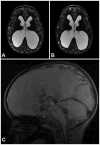Longitudinal comparison of diffusion tensor imaging parameters and neuropsychological measures following endoscopic third ventriculostomy for hydrocephalus
- PMID: 22656255
- PMCID: PMC4558885
- DOI: 10.3171/2012.2.PEDS11331
Longitudinal comparison of diffusion tensor imaging parameters and neuropsychological measures following endoscopic third ventriculostomy for hydrocephalus
Abstract
The authors report the case of a 25-month-old boy who underwent endoscopic third ventriculostomy (ETV) for hydrocephalus resulting from aqueductal stenosis. The patient's recovery was monitored longitudinally and prospectively using MR diffusion tensor imaging (DTI) and formal neuropsychological testing. Despite minimal change in ventricle size, improvement in the DTI characteristics and neurodevelopmental trajectory was observed following ETV. These data support the use of DTI as a biomarker to assess therapeutic response in children undergoing surgical treatment for hydrocephalus. In the patient featured in this report, DTI appeared to provide more information regarding postoperative neurodevelopmental outcome than ventricle size alone.
Figures



Similar articles
-
Endoscopic third ventriculostomy and choroid plexus cauterization in infant hydrocephalus: a prospective study by the Hydrocephalus Clinical Research Network.J Neurosurg Pediatr. 2018 Mar;21(3):214-223. doi: 10.3171/2017.8.PEDS17217. Epub 2017 Dec 15. J Neurosurg Pediatr. 2018. PMID: 29243972
-
Diffusion tensor imaging study of pediatric patients with congenital hydrocephalus: 1-year postsurgical outcomes.J Neurosurg Pediatr. 2016 Sep;18(3):306-19. doi: 10.3171/2016.2.PEDS15628. Epub 2016 May 20. J Neurosurg Pediatr. 2016. PMID: 27203134 Free PMC article.
-
Surgical outcome of tuberculous meningitis hydrocephalus treated by endoscopic third ventriculostomy: prognostic factors and postoperative neuroimaging for functional assessment of ventriculostomy.J Neurosurg Pediatr. 2009 May;3(5):371-7. doi: 10.3171/2009.1.PEDS0947. J Neurosurg Pediatr. 2009. PMID: 19409015
-
Endoscopic third ventriculostomy for hydrocephalus: a review of indications, outcomes, and complications.Neurol India. 2011 Nov-Dec;59(6):848-54. doi: 10.4103/0028-3886.91364. Neurol India. 2011. PMID: 22234198 Review.
-
Endoscopic re-opening of third ventriculostomy: Case series and review of literature.Clin Neurol Neurosurg. 2016 Jun;145:58-63. doi: 10.1016/j.clineuro.2016.04.007. Epub 2016 Apr 11. Clin Neurol Neurosurg. 2016. PMID: 27088221 Review.
Cited by
-
Left hemisphere structural connectivity abnormality in pediatric hydrocephalus patients following surgery.Neuroimage Clin. 2016 Sep 4;12:631-639. doi: 10.1016/j.nicl.2016.09.003. eCollection 2016. Neuroimage Clin. 2016. PMID: 27722087 Free PMC article.
-
MR diffusion changes in the perimeter of the lateral ventricles demonstrate periventricular injury in post-hemorrhagic hydrocephalus of prematurity.Neuroimage Clin. 2019;24:102031. doi: 10.1016/j.nicl.2019.102031. Epub 2019 Oct 8. Neuroimage Clin. 2019. PMID: 31795043 Free PMC article.
-
Ventricular volume and neurocognitive outcome after endoscopic third ventriculostomy: is shunting a better option? A review.Childs Nerv Syst. 2016 May;32(5):775-80. doi: 10.1007/s00381-016-3032-3. Epub 2016 Feb 9. Childs Nerv Syst. 2016. PMID: 26861009 Review.
-
Longitudinal Changes in the Brain Following Third Ventriculostomy in a Child With Hydrocephalus: A Case Report.Medicine (Baltimore). 2015 Nov;94(47):e2095. doi: 10.1097/MD.0000000000002095. Medicine (Baltimore). 2015. PMID: 26632724 Free PMC article.
-
Feasibility of fast brain diffusion MRI to quantify white matter injury in pediatric hydrocephalus.J Neurosurg Pediatr. 2019 Jul 19;24(4):461-468. doi: 10.3171/2019.5.PEDS18596. Print 2019 Oct 1. J Neurosurg Pediatr. 2019. PMID: 31323624 Free PMC article.
References
-
- Achenbach TM, Rescorla LA. Manual for the ASEBA Preschool Forms and Profiles. Burlington, VT: University of Vermont Research Center for Children, Youth and Families; 2000.
-
- Air EL, Yuan W, Holland SK, Jones BV, Bierbrauer K, Altaye M, et al. Longitudinal comparison of pre- and postoperative diffusion tensor imaging parameters in young children with hydrocephalus. Clinical article. J Neurosurg Pediatr. 2010;5:385–391. - PubMed
-
- Basser PJ, Pierpaoli C. Microstructural and physiological features of tissues elucidated by quantitative-diffusion-tensor MRI. J Magn Reson B. 1996;111:209–219. - PubMed
-
- Bayley N. Bayley Scales of Infant and Toddler Development. 3. San Antonio, TX: Psychological Corporation; 2005.

